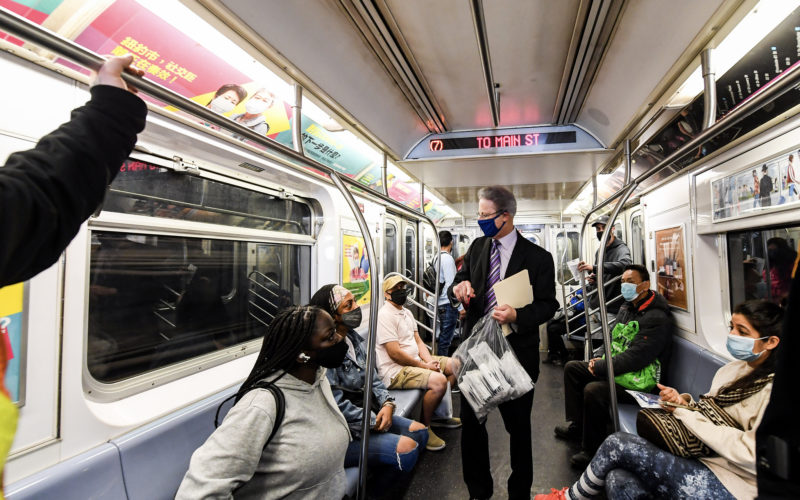

Image provided by Jarrett Walker + Associates
We’re constantly reminding non-transit professionals that transit is a means to multiple ends: to improved air quality and reduced carbon pollution, to economic opportunity, or to urban vitality. “We’re not in favor of transit just because we like trains and buses for their own sakes,” we tell our friends – perhaps a little disingenuously because secretly some of us really do love trains and buses for their own sakes – “we’re in favor of transit because of what it does for the city. Less traffic, more access for all, and better real estate development patterns.”
So what’s a booster or an old grizzled pro to do when Jarrett Walker comes to town with his “Human Transit” lecture and network design workshop? We recently found out when we sponsored his visit to New York. Walker stipulates to all the important by-products of transit – catalyzing development, economic growth – but then like a methodical professor he takes our brains back to some fundamentals that perhaps we have been taking for granted: what do we want transit to do, not just in macro service to the city, but in direct service to the rider? In an industry where “customer service” is sometimes more of a slogan than a daily reality, Walker’s deceptively erudite focus on the passenger is a refreshing elevation of some truths that often go unspoken: that reliability and trip duration are more important than the paint scheme on the vehicle. Or as I once said myself when visiting a sprawling western U.S. city, if the dazzling trip planning app on my smart phone has attractive graphics and fonts but tells me the next bus isn’t coming for another 45 minutes and will eventually drop me on an arterial without a sidewalk, two miles from my ultimate destination, the fancy information technology and an unlimited electronic fare card won’t going to entice me to choose transit.
Throughout his two day workshop at our office and in the well-attended lecture he delivered at Parsons School of Design / The New School, entitled “Abundant Access: Transit as an instrument of freedom,” Walker relentlessly reminded us that freedom in relation to transit is not an ideology but consists in the practical ability to get to more places. His message is particularly well-suited to cities facing choices about building new or expanded systems. Walker is spot-on in framing what those choices actually are. He would say that the threshold choice, for example, is not between bus rapid transit or light rail transit, which is an implementation question about vehicle type. More fundamental choices need to be considered first, such as how much geographic territory you want to cover and what places in your community you want to connect and at what frequencies. Decisions about what type of vehicle (bus or streetcar or light rail) can be derived from the operating characteristics and budget that create the context. Graphically he made the point that the most revealing map of a transit’s agency’s effectiveness is one that shows how many places a passenger can get to in a certain amount of time, rather than a collection of lines that doesn’t connote frequency of service and hours of operation. One of his most compelling slides revealed how ridership correlates to the quantity of service-hours offered, a measure by which most Canadian systems greatly out-perform their U.S. counterparts.
Thirty-six transit and planning professionals from as far as Florida and Los Angeles and Vancouver converged on our office for the workshop, and 250 urbanists gathered at the Parsons / New School lecture. Those are well-informed audiences who already know what the value of transit is in making a better city, and they needed no convincing about the importance of climate change or transit-oriented development. Walker enlightened these experienced transit aficionados with a more sophisticated way of thinking about simpler things: Reliability. Access to more places. Overall trip duration, which is a function of both speed and frequency. As he put it, the geometry and quantifiable attributes of transit, rather than its more subjective claims. We must believe in both, and make transit an instrument that serves the customer and the city.
 On the Brink: Will WMATA’s Progress Be Erased by 2024?
On the Brink: Will WMATA’s Progress Be Erased by 2024?
The experience of being a WMATA rider has substantially improved over the last 18 months, thanks to changes the agency has made like adding off-peak service and simplifying fares. Things are about to get even better with the launch of all-door boarding later this fall, overnight bus service on some lines starting in December, and an ambitious plan to redesign the Metrobus network. But all of this could go away by July 1, 2024.
Read More What’s Going on With Transit Service at the Seven Highest Ridership U.S. Cities? NYC Edition
What’s Going on With Transit Service at the Seven Highest Ridership U.S. Cities? NYC Edition
New York City Transit’s service levels have remained remarkably strong throughout the pandemic. Crew operator availability remains the agency’s biggest challenge, as well as adjusting weekend maintenance schedules in order to run service that matches strong weekend demand.
Read More